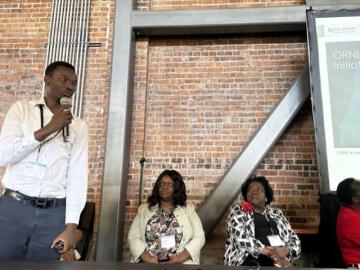
Filter News
Area of Research
- Advanced Manufacturing (5)
- Biological Systems (1)
- Biology and Environment (103)
- Biology and Soft Matter (4)
- Building Technologies (2)
- Chemical and Engineering Materials (3)
- Chemistry and Physics at Interfaces (7)
- Computational Biology (1)
- Computational Chemistry (5)
- Computational Engineering (1)
- Computer Science (3)
- Data (1)
- Electricity and Smart Grid (1)
- Energy Frontier Research Centers (7)
- Energy Science (169)
- Fuel Cycle Science and Technology (2)
- Functional Materials for Energy (8)
- Fusion and Fission (33)
- Fusion Energy (7)
- Geographic Information Science and Technology (1)
- Isotopes (22)
- Materials (122)
- Materials for Computing (13)
- Materials Synthesis from Atoms to Systems (8)
- Materials Under Extremes (7)
- National Security (45)
- Neutron Data Analysis and Visualization (2)
- Neutron Science (94)
- Nuclear Science and Technology (27)
- Quantum Condensed Matter (3)
- Quantum information Science (4)
- Sensors and Controls (2)
- Supercomputing (160)
- Transportation Systems (4)
News Type
News Topics
- 3-D Printing/Advanced Manufacturing (56)
- Advanced Reactors (12)
- Artificial Intelligence (77)
- Big Data (45)
- Bioenergy (68)
- Biology (80)
- Biomedical (42)
- Biotechnology (25)
- Buildings (30)
- Chemical Sciences (35)
- Clean Water (16)
- Composites (11)
- Computer Science (111)
- Coronavirus (19)
- Critical Materials (5)
- Cybersecurity (14)
- Education (2)
- Emergency (3)
- Energy Storage (32)
- Environment (116)
- Exascale Computing (51)
- Fossil Energy (6)
- Frontier (44)
- Fusion (38)
- Grid (32)
- High-Performance Computing (81)
- Hydropower (6)
- Isotopes (33)
- ITER (4)
- Machine Learning (37)
- Materials (51)
- Materials Science (55)
- Mathematics (8)
- Mercury (7)
- Microelectronics (3)
- Microscopy (23)
- Molten Salt (2)
- Nanotechnology (17)
- National Security (60)
- Neutron Science (82)
- Nuclear Energy (66)
- Partnerships (36)
- Physics (34)
- Polymers (9)
- Quantum Computing (35)
- Quantum Science (48)
- Security (16)
- Simulation (42)
- Software (1)
- Space Exploration (13)
- Statistics (2)
- Summit (40)
- Transportation (30)
Media Contacts

Since their establishment in 2020, the five DOE National Quantum Information Science Research Centers have been expanding the frontier of what’s possible in quantum computing, communication, sensing and materials in ways that will advance basic science for energy, security, communication and logistics.

A research collaboration between the Department of Energy’s Oak Ridge National Laboratory and several partner institutions was honored with the Best Event Report award at the 2024 International Conference on Game Jams, Hackathons and Game Creation Events.

Researchers are using machine learning to provide a more complete picture of building geometries that include building height to within three meters of accuracy. This model not only provides building height for any building in the world, but it will also feed into LandScan and other large government datasets for planning and response.

Scientists and land managers interested in accessing the first dataset of its kind on one of the most biologically diverse ecosystems in the world were given hands-on tutorials during a recent workshop by researchers supporting the ORNL Distributed Active Archive Center for Biogeochemical Dynamics.

FREDA is a new tool being developed at ORNL that will accelerate the design and testing of next-generation fusion devices. It is the first tool of its kind to combine plasma and engineering modeling capabilities and utilize high performance computing resources.

The Department of Energy’s Oak Ridge National Laboratory had a major presence at this year’s International Conference for High Performance Computing, Networking, Storage, and Analysis (SC24).



Scientists at the Department of Energy’s Oak Ridge National Laboratory recently demonstrated an autonomous robotic field monitoring, sampling and data-gathering system that could accelerate understanding of interactions among plants, soil and the environment.

ORNL researchers reached a significant milestone by building an entire 6.5-foot turbine blade tip using novel materials. The team then tested it against the forces of simulated lightning in a specialized lab at Mississippi State University, where the blade tip emerged pristine after tests that isolate the effects of high voltage.


